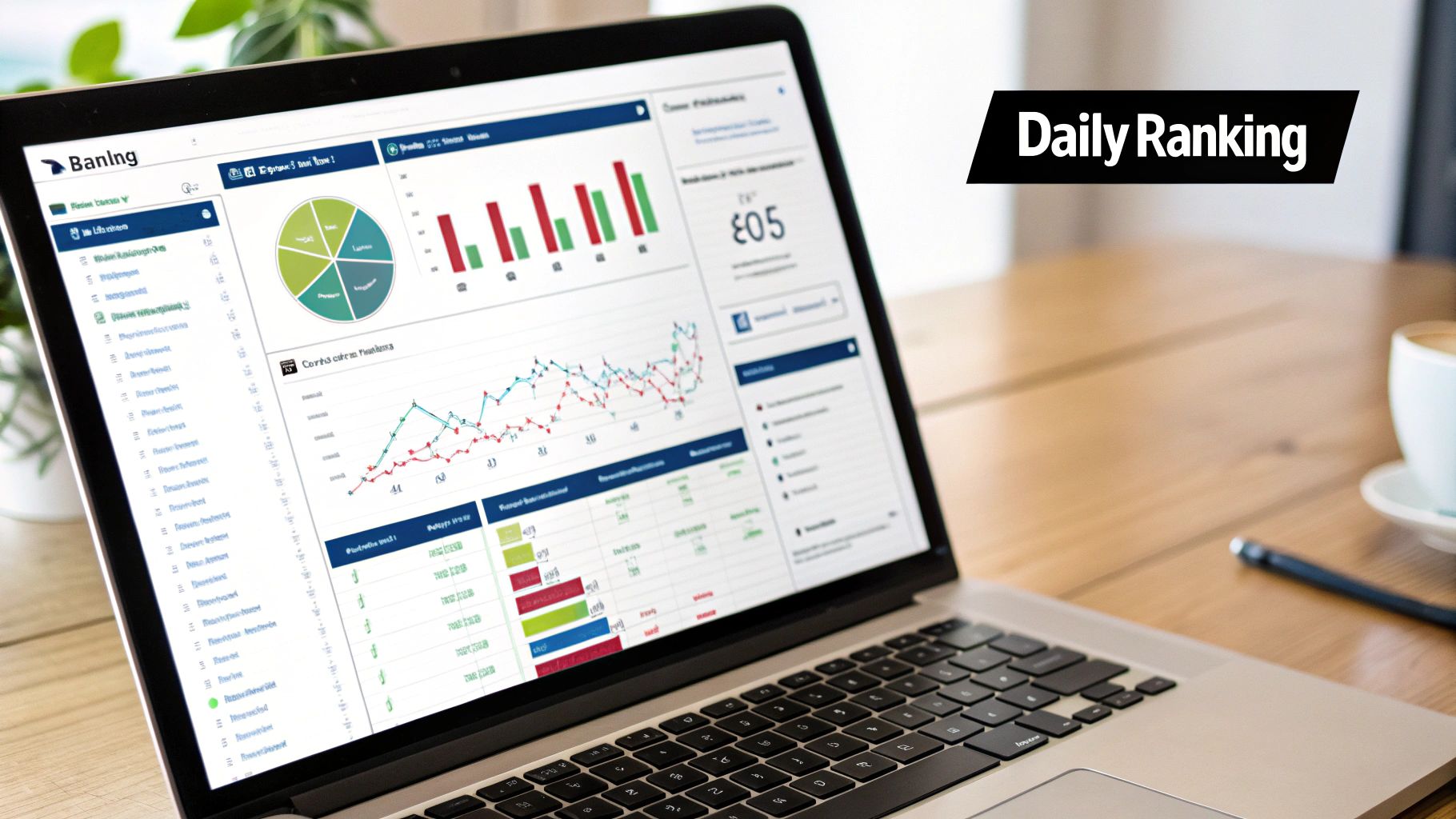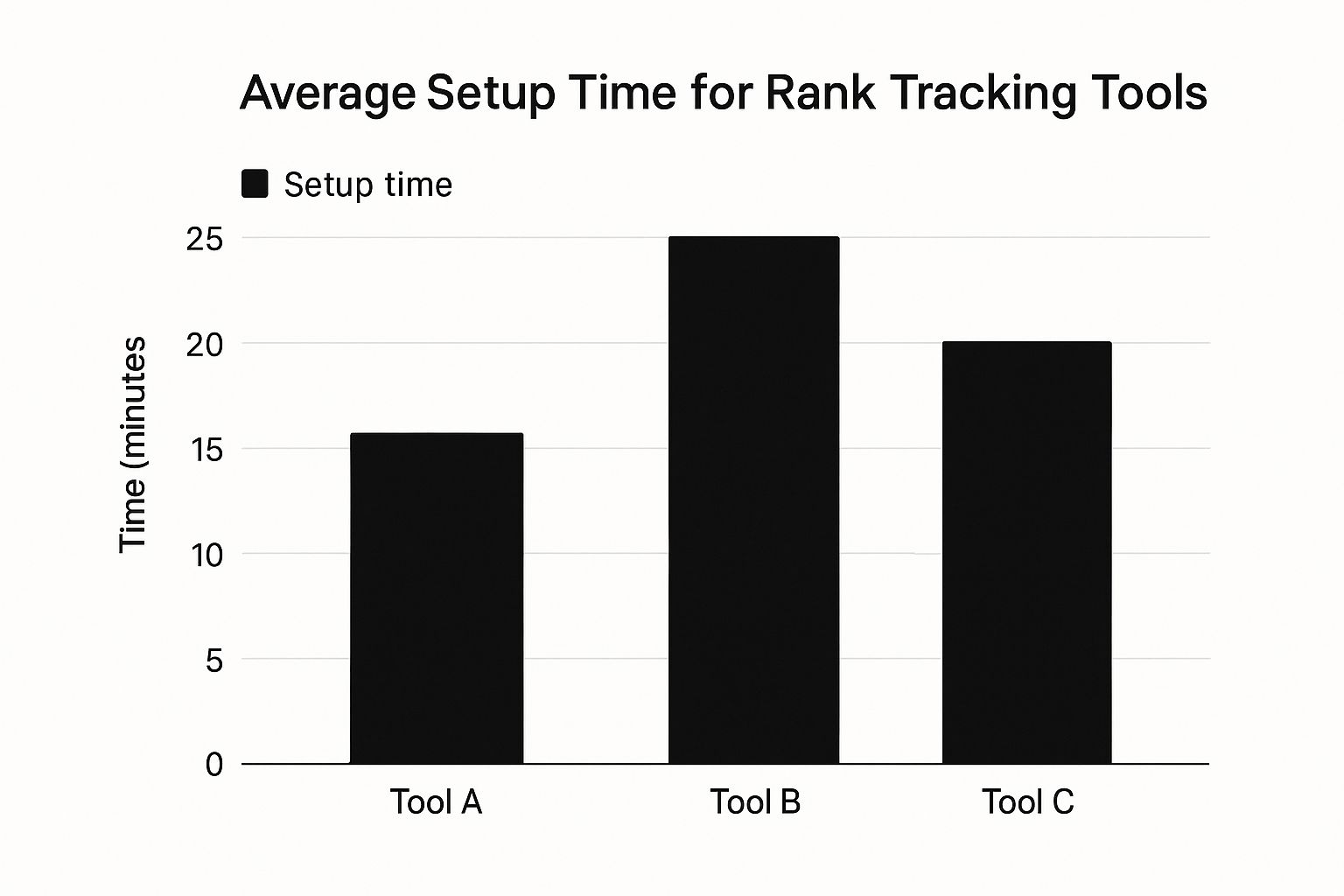Why Daily Rank Tracking Is Your SEO Competitive Edge
In the fast-paced SEO world, staying ahead isn't just about best practices; it's about reacting quickly. Imagine driving with impaired vision: you might arrive, but the journey will be risky. Similarly, relying on weekly or monthly rank checks blinds you to daily fluctuations impacting your online visibility. Leading SEO teams use daily rank tracking as their secret weapon.
This daily monitoring shift isn't a trend, but a necessity. Algorithm updates, competitor actions, and even user signal shifts can reshape the search landscape overnight. Daily rank tracking provides immediate visibility into these changes, offering both defensive and offensive opportunities. A sudden ranking drop could signal a technical issue, a penalty, or a new competitor strategy.
Additionally, daily rank tracking offers real-time insight into algorithm fluctuation effects. Understanding how these changes impact your site requires immediate awareness, as rankings can shift rapidly due to algorithm updates, tests, and user intent changes. seoClarity allows both daily and hourly tracking, providing dynamic SERP insights, including the impact of SERP features on visibility.
This level of tracking is invaluable for enterprise brands managing thousands of keywords across search engines like Google, Bing, and Naver. Leveraging this data lets businesses respond quickly to ranking shifts, optimizing SEO strategies to protect and improve their positions. This proactive approach is vital in today's environment, where up-to-the-minute data is key to outpacing competitors. You can also check out: That's Rank Sitemap
This means addressing problems within hours, minimizing losses and maximizing recovery speed. This responsiveness is the power of daily rank tracking – catching a ranking drop the same day versus weeks later, after significant traffic loss. This proactive approach is crucial for maintaining a competitive advantage.
The Business Impact of Daily Tracking
Daily tracking benefits go beyond simply knowing your rankings. It directly impacts your business. By quickly identifying and resolving issues, you protect organic traffic, a crucial source of leads and revenue. Spotting competitor moves early lets you adapt and stay ahead.

This proactive approach isn't just defensive; it's about seizing opportunities missed by slower competitors. For serious SEO professionals, daily rank tracking isn't a luxury, but a necessity. It's about gaining an edge, maximizing SEO investment returns, and achieving sustainable online growth.
Essential Features That Make Daily Rank Tracking Actionable
Daily rank tracking is more than simply monitoring numbers; it's about uncovering actionable insights that drive strategic decisions. However, choosing the right tool is crucial, as not all rank trackers offer the features necessary to transform data into meaningful action.
Location and Device-Specific Tracking
For businesses targeting diverse demographics or operating across multiple locations, location-specific tracking is paramount. For example, a national retail chain can use location-specific data to understand ranking fluctuations in different cities, enabling them to refine local SEO strategies. Similarly, device-specific data is essential in today's mobile-first environment. A website performing well on desktops but poorly on mobile devices is likely missing a significant portion of its potential audience.
Historical Benchmarking and Alert Configurations
Daily ranking changes can be misleading without proper context. Historical benchmarking offers this crucial perspective, transforming daily fluctuations into understandable trends. This allows you to see the long-term performance of your keywords and determine if a ranking drop is a temporary anomaly or a sign of a larger issue. Alert configurations further enhance this actionability. Instead of being bombarded with constant notifications, smart alerts only notify you of significant changes, such as a substantial drop in rankings for your most valuable keywords. This focused approach ensures you're addressing the most critical issues.
To illustrate the importance of these features, let's take a look at a comparison of essential daily rank tracking features for businesses of all sizes.
Essential Daily Rank Tracking Features Comparison
A comparative analysis of must-have features in rank tracking tools for businesses of different sizes
| Feature | Small Business Needs | Mid-Market Requirements | Enterprise Necessities |
|---|---|---|---|
| Location-Specific Tracking | Essential for local businesses | Crucial for regional expansion | Mandatory for national/international brands |
| Device-Specific Tracking | Important for reaching mobile users | Vital for optimizing mobile conversions | Critical for understanding cross-device behavior |
| Historical Benchmarking | Helpful for identifying trends | Necessary for strategic planning | Indispensable for long-term SEO success |
| Alert Configurations | Useful for monitoring key changes | Important for efficient issue management | Essential for automating responses to critical ranking drops |
| Visualization Dashboards | Helpful for quick overview of performance | Necessary for analyzing complex data sets | Crucial for communicating insights across teams |
| Integration Capabilities | Beneficial for streamlining workflow | Important for connecting data sources | Essential for a unified view of marketing performance |
This table highlights how the importance of each feature scales with the size and complexity of the business. While all features are beneficial, some become absolutely critical as businesses grow and their SEO strategies become more intricate.
Advanced tools like Similarweb offer sophisticated rank tracking capabilities, allowing businesses to monitor daily trends, analyze competitor performance, and gain strategic insights for improving their own rankings. By tracking performance across different devices and locations – from country-level down to specific zip codes – businesses can tailor their SEO strategies effectively. Features like click metrics and competitor reports provide further actionable insights, helping identify opportunities for improvement, such as addressing keyword cannibalization or targeting competitor keywords.
Visualization Dashboards and Integration Capabilities
Even with the best data, complex information can be overwhelming. Visualization dashboards transform raw data into digestible charts and graphs, simplifying the process of spotting trends, identifying potential problems, and communicating these insights to stakeholders. Integration capabilities are also crucial for a seamless analytics ecosystem. Integrating your rank tracking tool with other platforms like Google Analytics and Google Search Console creates a holistic view of your overall SEO performance.
Setup Time Comparison
The time required to set up a rank tracking tool can impact how quickly you start gathering valuable data. The infographic below compares the average setup time for three common tools.

As the infographic illustrates, Tool A boasts the fastest setup time at 15 minutes, enabling quick rank tracking. Tool C follows at 20 minutes, while Tool B requires the longest setup at 25 minutes. Choosing a tool with a streamlined setup process, like That's Rank, saves valuable time and allows for faster implementation of your SEO strategy. Implementing a daily rank tracking strategy is a critical element in your overall SEO efforts, especially in competitive industries such as tech startups. Learn more about effective strategies with SEO for Tech Startups. Combining these features ensures your daily rank tracking translates into tangible improvements, giving you a competitive advantage.
Building Your Daily Rank Tracking Workflow That Drives Action
Daily rank tracking offers a wealth of knowledge. However, without a structured approach, it can easily become overwhelming. Building an effective workflow is essential for extracting actionable insights and avoiding data overload. This involves segmenting keywords, setting baselines, creating efficient check-in routines, and establishing clear response protocols.
Prioritizing Keywords and Establishing Baselines
Not all keywords hold the same value. Segment your keywords into priority tiers based on their business value and search volume. For instance, keywords directly related to your core offerings should occupy the highest tier, requiring close monitoring. Lower-tier keywords, perhaps related to broader industry themes, can be tracked less often. This targeted approach helps allocate resources to the keywords that truly impact your business.
After tiering your keywords, establish baseline metrics. This creates a benchmark against which you can measure daily fluctuations. Instead of reacting to every minor shift, concentrate on significant deviations from the baseline, as these indicate noteworthy movement.
Daily Check-In Routines and Response Protocols
Implement a morning check-in routine to review daily ranking data. This could involve a quick overview of your top-tier keywords, checking for significant changes from the baseline. For example, a sudden drop for a high-value keyword may necessitate immediate investigation.
Develop cross-functional response protocols for varying ranking scenarios. A ranking decline might initiate a technical SEO audit with a tool like Semrush, while an increase could prompt content promotion activities. Well-defined protocols ensure a swift and organized response to any ranking fluctuations.
Daily rank tracking is essential for maintaining online visibility and competitiveness. As of 2024, platforms like ProRankTracker provide in-depth keyword performance and competitor analysis, enabling businesses to refine their SEO strategies. Daily tracking allows you to monitor the effects of Google's algorithm updates, which can significantly impact search visibility. Google updates its algorithms numerous times each year, and daily data empowers businesses to react promptly to SERP changes. ProRankTracker and similar platforms support this proactive approach, offering insights for timely SEO adjustments in dynamic markets. Discover more insights about daily rank tracking here.
You might be interested in: How to master daily rank tracking
Delegating Responsibilities and Executive Reporting
For larger teams, delegate monitoring responsibilities effectively. Assign specific keyword groups or competitor sets to individual team members, fostering ownership and accountability.
Create executive reporting that clearly conveys the business impact of your SEO efforts. Instead of overwhelming executives with raw data, focus on important metrics like organic traffic growth, conversion rates, and revenue generated from organic search. This concise reporting keeps stakeholders informed and demonstrates the value of your daily tracking work.
Real-World Workflow Examples
Many companies have integrated daily rank tracking into their operations. Some utilize automated reporting tools that provide key insights directly to relevant team members daily. Others use customized dashboards that visualize ranking data alongside other crucial performance indicators. These real-world examples showcase the practical application of daily rank tracking and the tangible benefits it offers.
By implementing a structured workflow, you can unlock the full potential of daily rank tracking, converting it from a data dump into a powerful driver of SEO success. This enables quick identification of problems and opportunities, resulting in more effective and proactive SEO strategies.

Detecting Algorithm Shifts Before Your Competitors React
Search engines are in constant flux, deploying hundreds of algorithm updates every year, many of which go unannounced. This makes daily rank tracking a vital early warning system. It allows you to spot these shifts and adapt before your competitors even know what's happening.
Identifying Algorithm Shifts vs. Normal Fluctuations
It's crucial to differentiate between typical ranking volatility and actual algorithm shifts. Properly analyzed daily rank tracking data gives you the necessary insights. A sudden, broad drop across numerous keyword clusters, especially those targeting various facets of your business, might indicate an algorithm update.
Likewise, if your rankings plummet and your competitors experience similar declines, it’s less likely a problem with your site and more likely an industry-wide algorithmic change. Even shifts in SERP features, like the appearance or disappearance of featured snippets for your keywords, can point to an algorithm update.
Correlation Techniques and On-Page Factor Analysis
Understanding the link between ranking changes and particular on-page factors is key to grasping the effect of algorithm updates. Tools like That's Rank let you correlate daily ranking data with on-page adjustments, such as title tag modifications or content refreshes.
This helps identify which elements of your SEO strategy need tweaking. For example, if rankings climb after optimizing title tags for a certain keyword cluster, it suggests the algorithm may be prioritizing title tag relevance. You can then apply this tactic to other related keywords.
Validating Suspected Updates and Developing Response Protocols
Suspecting an update isn't enough; you need to validate it. Look for discussions on industry forums, SEO news websites, and social media about similar ranking changes. Tools like That's Rank can also offer insights into broader industry trends. This collective intelligence helps verify whether a suspected update is affecting a wider range of sites.
Daily rank tracking is invaluable here, providing the foresight to act quickly while your competitors remain unaware. Once an update is confirmed, implementing the right response is critical. Different updates require different reactions.
A content-focused update might mean reviewing and refreshing existing content, while a technical update might call for technical SEO audits using tools like Semrush. That's Rank lets you track these changes and monitor their impact. Having pre-established response protocols for various update scenarios streamlines this process, ensuring a swift and organized reaction. This agility can mean maintaining, or even expanding, your valuable market share.
Unlocking Competitor Strategies Through Daily Rank Tracking

Your competitors' wins and losses in the search ranking game offer valuable insights. Daily rank tracking transforms this raw data into actionable competitive intelligence. Understanding their tactics and weaknesses is key to gaining an edge.
Structuring Competitor Tracking Groups
Don't track every competitor. Focus on your true business rivals: those targeting the same audience and keywords as you. Tools like That's Rank allow you to segment and monitor these key competitors, providing more relevant data. This targeted approach helps you zero in on the most impactful competitive strategies.
Detecting New Keyword Targets and Content Approaches
Daily rank tracking reveals when competitors target new keywords. A sudden ranking jump for a term you weren't tracking might signal a new campaign. This early detection lets you respond proactively. Creating your own content targeting that keyword is a good first step. You can then use daily tracking to measure the effectiveness of your response.
Daily tracking can also highlight successful content approaches. If a competitor's blog post quickly climbs in rankings, analyzing it can reveal what's working. Perhaps they've adopted a new format or are focusing on an untapped niche. Learn from their success and adapt your own content strategy. Staying ahead of algorithm shifts is critical, and daily tracking can help you react faster. You might find some additional information relevant in this article about Instagram Algorithm Updates.
Reverse-Engineering Ranking Improvements and Identifying Industry Trends
Analyzing the timing between competitors' page updates and subsequent ranking changes can reveal what drives their success. This reverse-engineering process helps uncover hidden tactics. For example, a competitor might see a ranking boost after updating page content or acquiring new backlinks. That's Rank lets you monitor these changes and understand their effects.
Daily tracking also helps identify broader industry trends. By aggregating data across multiple competitors, you can spot emerging keyword themes and shifts in search behavior. A sudden increase in rankings for keywords related to a specific product feature might indicate growing consumer interest. Anticipate market demands and adjust your offerings accordingly. For a deeper dive into SEO terms, see our article on SEO terminology.
The following table illustrates how tracking specific metrics can unveil competitor strategies and inform your responses.
Daily Rank Tracking Metrics That Reveal Competitor Strategies Key tracking data points and what they reveal about competitor SEO tactics
| Tracking Metric | What It Reveals | How to Respond | Priority Level |
|---|---|---|---|
| Keyword Ranking Changes | New keyword targets, content effectiveness, algorithm impacts | Create competing content, optimize existing pages, adjust keyword strategy | High |
| Backlink Acquisition | Link building campaigns, new partnerships, content promotion efforts | Analyze backlink profile, identify link opportunities, build relationships | Medium |
| Content Updates | Freshness of content, keyword targeting adjustments, improved user experience | Review competitor content, update your own content, analyze on-page optimization | Medium |
| Ranking Volatility | Algorithm updates, competitor actions, technical issues | Monitor SERP features, analyze competitor activity, check website health | High |
| Competitor Content Performance | Successful content formats, trending topics, audience engagement | Analyze content strategy, adapt successful formats, create engaging content | Medium |
By tracking these metrics, you can gain a deeper understanding of competitor activities and develop informed responses.
Gap Analysis: Uncovering Untapped Keyword Opportunities
Daily rank tracking facilitates gap analysis. This involves identifying relevant keywords your competitors aren't targeting. These untapped keywords are low-hanging fruit, offering opportunities to rank and attract traffic without intense competition. That's Rank simplifies this process. By highlighting these overlooked keywords, daily tracking unlocks opportunities for creating a significant competitive advantage.
Making Sense of Daily Ranking Fluctuations That Actually Matter
Not every change in your search engine rankings requires immediate attention. This section helps you distinguish between significant shifts and the typical daily fluctuations. Think of it like observing the stock market: there's always some movement, but investors primarily focus on significant trends.
Establishing Statistical Significance
Ranking fluctuations are a normal part of the online landscape. Search engines like Google constantly update their algorithms, user behavior evolves, and competitors implement their own strategies. This creates a dynamic environment where rankings naturally shift. How then, can you define "significant"?
This depends on several factors, including your keyword category and search volume. For highly competitive keywords with substantial search volume, even minor changes can have a noticeable impact. On the other hand, for niche keywords with lower search volume, larger fluctuations might be less concerning.
For example, a one-position drop for a high-volume keyword could substantially affect website traffic, whereas a five-position drop for a low-volume keyword might be negligible. That's Rank provides context for this data, helping you analyze these fluctuations effectively.
Correlation Methods for Determining True Causation
Daily rank tracking becomes truly insightful when you can connect ranking changes to specific actions. This involves correlating ranking movements with various factors:
- On-Site Modifications: Did a recent content update correspond with a ranking improvement?
- Backlink Acquisitions: Did acquiring several high-quality backlinks coincide with higher rankings?
- Competitor Movements: Did a competitor's new content strategy cause a decline in your rankings?
That's Rank helps you analyze these correlations, identifying true cause-and-effect relationships. It's essential to understand why a ranking change occurred, not just that it happened. This knowledge allows you to repeat successful strategies and address potential issues.
Understanding the Influence of External Factors
Several external factors can temporarily influence your rankings:
- Seasonal Patterns: Some industries experience predictable ranking fluctuations based on the time of year. Travel-related keywords, for instance, often see increased rankings during popular vacation periods.
- News Events: Current events can significantly impact rankings for relevant keywords. A major product recall, for example, could temporarily lower rankings for the affected brand.
- SERP Feature Changes: The presence or absence of SERP features (like featured snippets and knowledge panels) can significantly affect click-through rates and traffic.
Tracking these patterns within That's Rank provides valuable context for your daily ranking data. This historical perspective helps you recognize recurring trends and anticipate future fluctuations. It allows you to distinguish between temporary external influences and more permanent ranking shifts.
Developing Actionable Decision Trees
Finally, develop decision trees to guide your response to ranking fluctuations. These decision trees should define clear thresholds for action:
- Significant Drop: A drop of more than five positions for a high-priority keyword could trigger an immediate investigation, potentially including a technical SEO audit.
- Minor Fluctuation: A small fluctuation within the normal range might not require immediate action, but warrants continued monitoring.
This structured approach ensures you’re focusing your efforts on the most important ranking changes while maintaining an overview of your overall performance. That's Rank can help automate this process by alerting you to significant changes and providing the data necessary to make informed decisions.